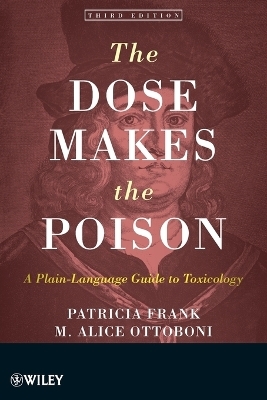
The Dose Makes the Poison
John Wiley & Sons Inc (Verlag)
978-0-470-38112-0 (ISBN)
This new edition of a widely-read and highly-acclaimed book broadens the scope of its predecessors from a heavy focus on industrial chemicals as toxicants to include drugs, food additives, cosmetics and other types of compounds that people are exposed to daily. Also new to the 3rd edition are newer issues-of-the-day such as nanoparticulate toxicants, second hand smoke, food contamination, lead in toys, and others. As such, the book provides the basics of toxicology in easy-to-understand language as well as a fuller understanding of the daily insults to which our bodies are subjected.
Patricia Frank is President of Patricia Frank & Associates, Inc., a consulting firm founded in 1993 that assists companies in the development and registration of human and veterinary pharmaceutical agents. She is a past president of both the American College of Toxicology and the Roundtable of Toxicology Consultants. M. Alice Ottoboni lectures, writes, and consults in the field of toxicology. As Staff Toxicologist with the California State Department of Public Health for over twenty years, she originated, designed, and performed numerous toxicological studies of environmental factors of importance to public health. She is the author of the previous editions of The Dose Makes the Poison.
Introduction to the Third Edition xi
Preface to the Second Edition xv
1 WHAT ARE CHEMICALS? 1
Atoms and Molecules 1
Natural Chemicals 2
Synthetic Chemicals 3
Chemical Categories 6
Chemicals: “Good” and “Bad” 8
Why the “Good-Bad” Dichotomy? 10
Man-made Chemicals Are Made by Humans 11
Man-made Chemicals May Not Be Biodegradable 12
Man-made Chemicals May Be Very Complex 16
2 WHAT HARM DO CHEMICALS CAUSE? 19
Harmful Properties of Chemicals 19
Explosiveness and Reactivity 19
Flammability and Combustibility 20
Radioactivity 21
Corrosiveness 23
Irritation 23
Sensitization and Photosensitization 24
Toxicity 26
Multiple Harmful Properties 27
Definition of Poison 28
Defi nition of Hazard 28
3 WHAT IS TOXICOLOGY? 31
Empirical Toxicology 31
Paracelsus and Ramazzini 32
A Brief History of Toxicology 34
Toxicology Today 40
What Do Toxicologists Do? 44
4 WHAT FACTORS INFLUENCE THE TOXIC EFFECTS OF CHEMICALS? 47
Acute versus Chronic Toxicity 47
Significance of Divided Doses 53
Routes of Exposure 54
Dermal Exposure 54
Inhalation Exposure 55
Oral Exposure 58
Other Routes of Exposure 59
Combinations 60
Influence of Route on Toxicity 60
Metabolism 64
Routes of Elimination (Excretion) 65
Other Factors that Infl uence Toxicity 66
Species 66
Sex 70
Age 71
Nutrition 73
State of Health 73
Biochemical Individuality (Genetic Diversity) 74
Presence of Other Chemicals 75
Adaptation 77
Light 79
5 HOW IS TOXICOLOGY STUDIED? 81
Experimental Methods 82
Acute Toxicity 83
Irritant and Corrosive Effects 85
Sensitization and Photosensitization 86
Chronic Toxicity 87
Mutagenesis 90
Carcinogenesis 91
Developmental and Reproductive Toxicity 94
Units of Trace Quantities 95
Analytical Methods 96
Animal Rights 99
6 GENERAL TOXICOLOGY 103
Acute Toxicity 103
LD50 and LC50 Values 103
Signifi cance of LDs for Humans 104
Poison Prevention 109
Antidotes 112
Chronic Toxicity 114
No-Effect Levels and Thresholds 116
Margins of Safety 117
Sufficient Challenge 119
Bioaccumulation 121
7 MUTAGENESIS AND CARCINOGENESIS 129
Mutagenesis 129
Genetic Code 129
Mutations 130
Significance of Mutations 132
Mutation and Cancer 135
Carcinogenesis 138
What Is Cancer? 138
Causes of Cancer 140
Role of Mutation 141
Incidence of Cancer 142
Categories and Characteristics of Carcinogens 143
Induction Periods 146
Thresholds 147
Practical Thresholds 149
The Real World 150
Benzo[a]pyrene 150
Cancerophobia 151
8 DEVELOPMENTAL AND REPRODUCTIVE TOXICITY 153
Male and Female Reproductive Systems 154
Prepuberty Systems 154
Adult Systems 155
The Developing Individual 156
9 CASE STUDIES IN TOXICOLOGY 163
Environmental Contaminations 164
Dioxins: Seveso, Italy 164
PCBs and Dibenzofurans: Yusho Disease 169
Bophal, India 173
Minamata Disease 174
DDT 174
Consumer Products 177
Metals 177
Lead and Cadmium 178
Zinc 178
Plastics 179
Bisphenyl A 180
Indoor Air Pollution 181
Water Pollution 185
Pharmaceuticals 186
Fen-Phen 187
Vioxx 188
Thalidomide 189
10 EPIDEMIOLOGY 191
Origins of Modern Epidemiology 191
Epidemiology of Noninfectious Diseases 193
Koch’s Postulates 195
Study Design: Precepts and Pitfalls 197
Unreasonable Expectations 201
Proximate Event Approach in Assigning Cause 202
Distrust of Science and Scientists 204
11 THE STUDY OF RISK 211
Public Health Statistics 211
Inherent Risk 213
Risk Assessment 215
Perceived Risk 218
Acceptable Risk 220
Risk Benefit and Cost Benefit 222
Risk Communication 225
Risk Management 227
Bibliography 229
Abbreviations 233
Glossary 235
Appendix A 245
Index 247
| Verlagsort | New York |
|---|---|
| Sprache | englisch |
| Maße | 150 x 231 mm |
| Gewicht | 431 g |
| Themenwelt | Studium ► 2. Studienabschnitt (Klinik) ► Pharmakologie / Toxikologie |
| Naturwissenschaften ► Chemie | |
| ISBN-10 | 0-470-38112-4 / 0470381124 |
| ISBN-13 | 978-0-470-38112-0 / 9780470381120 |
| Zustand | Neuware |
| Haben Sie eine Frage zum Produkt? |
aus dem Bereich


